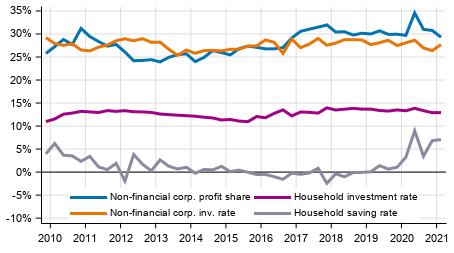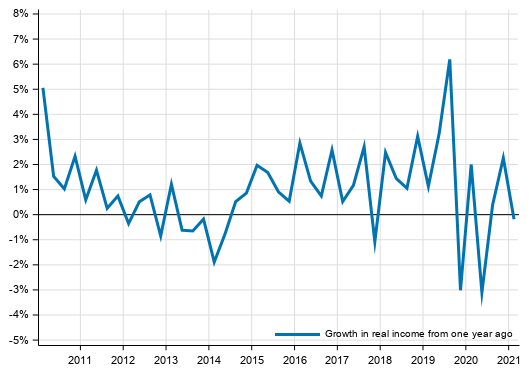Published: 23 June 2021
Households' saving rate still high in the first quarter
Households’ saving rate improved slightly in January to March from the previous quarter. Consumption expenditure fell slightly while disposable income was showing some growth. Households’ investment rate remained on level with the previous quarter. The profit share of non-financial corporations continued to fall. The profit share was lowered, on the one hand, by increased compensation of employees and, on the other hand, lower subsidies on production received. The investment rate of the non-financial corporations sector grew. These data derive from Statistics Finland’s quarterly sector accounts.
Key indicators for households and non-financial corporations, seasonally adjusted

The key figures were calculated from seasonally adjusted time series. Sector accounts are calculated only at current prices. However, an indicator describing the development adjusted for price changes is calculated for households' adjusted disposable income. The profit share, saving rate and investment rate are calculated from net figures, from which consumption of capital is removed. Households do not include non-profit institutions serving households.
The responsibility for collecting quarterly data on the finances of municipalities and joint municipal authorities was transferred from Statistics Finland to the State Treasury in early 2021: http://www.stat.fi/uutinen/quarterly-local-government-finances-published-for-the-first-time-on-the-exploreadministrationfi-service . The aim of the new data collection has been advanced automation. In addition, the collected data content is wider than before. Changes may initially have an effect on the quality and comparability of data concerning general government from the perspective of statistics..
Households
Households’ seasonally adjusted saving rate grew slightly from the data of the previous quarter and stood at 7.1 per cent in January to March. The saving is derived by deducting consumption expenditure from disposable income. The saving is positive if households' disposable income is greater than households' consumption expenditure. The saving rate refers to the share of households’ savings in disposable income. In the first quarter of 2021, households’ disposable income increased slightly from the previous quarter and as consumption expenditure diminished somewhat, the saving rate grew a little compared with the previous quarter.
Households’ seasonally adjusted investment rate remained on level with the previous quarter, 12.9 per cent. The investment rate is the ratio of households' investments to disposable income. Most of households' investments are investments in dwellings. Households’ investments remained, in practice, on level with the previous quarter, and as the disposable income did not change, the investment rate remained unchanged.
Compared with the corresponding quarter of the previous year, households’ disposable income was in practice unchanged in the first quarter of 2021. The key components of disposable income on the income side are wages and salaries received, entrepreneurial and property income, and social benefits received. The biggest expense items are taxes paid and social contributions. In the first quarter of 2021, received wages and salaries grew by around EUR 300 million, entrepreneurial income remained on level with the previous year, received property income declined by nearly EUR 400 million and received social benefits increased by good EUR 400 million compared with the figures one year ago. On the expense side, taxes paid increased by nearly EUR 200 million and social contributions paid grew by good EUR 100 million compared with the corresponding period of the previous year.
When individual services produced by the public sector and non-profit institutions, such as educational, health and social services, are added to disposable income, the concept of adjusted disposable income can be attained. Adjusted disposable income is the indicator recommended by the OECD for evaluating the economic well-being of households. In the first quarter of 2021, households’ adjusted disposable income grew at current prices by 0.9 per cent and adjusted for price changes decreased by 0.2 per cent from the corresponding quarter of the year before. The indicator describing the development of adjusted disposable income adjusted for price changes can be found in Appendix table 3 of this publication.
Volume development of households’ adjusted disposable income

Compensation of employees paid by non-profit institutions serving households decreased by 1.0 per cent compared with the quarter of one year ago. In the fields of both sports and culture, the activities of many associations started to recover slightly, but they did not recover to their full extent yet.
In these statistics, the households sector only covers the actual households sector S14. Sector S15, non-profit institutions serving households, is calculated and published separately. The households sector in Eurostat’s publications also includes the data for sector S15. Another difference to Eurostat's publication is in how consumption of fixed capital is taken into account. Eurostat publishes investment and saving rates as gross figures, i.e. including consumption of fixed capital. Net data are used in these statistics, that is, when consumption of fixed capital is taken into account, saving and investment rates decrease.
Profit share of non-financial enterprises fell from the previous quarter
In the first quarter of 2021, the seasonally adjusted profit share of non-financial corporations fell by 1.5 percentage points to 29.3 per cent. The profit share refers to the share of the operating surplus in value added. The profit share has fallen continuously since the second quarter of 2020. This development is explained by the fact that received subsidies on production have decreased and compensation of employees paid has grown relatively faster than value added. The operating surplus is calculated by deducting from value added compensation of employees paid and other taxes on production and by adding to it received subsidies on production.
The investment rate of non-financial corporations, or the proportion of fixed capital investments in value added grew by 1.3 percentage points to 27.7 per cent. Seasonally adjusted investments grew at the same time as value added remained almost on level with the previous quarter.
Profits of financial and insurance corporations grew
Seasonally adjusted value added in financial and insurance corporations grew by 4.4 per cent from the previous year's corresponding quarter. Output went up by 9.4 per cent and intermediate consumption by 13.9 per cent. The operating surplus describing profits in the sector was EUR 0.7 billion in the first quarter and it grew by 4.6 per cent. Compensation of employees paid, in turn, grew by four percentage points from one year ago.
Property income and expenditure fell from the respective quarter of the year before. The property expenditure of financial and insurance corporations was 2.3 per cent lower than in the corresponding quarter of the year before. Property income declined by 7.2 per cent, or by around EUR 0.2 billion. Property income includes dividends, interests and reinvested earnings. Of income and expenditure items, interest received and paid by monetary financial institutions particularly went down. In turn, dividends paid by the sector increased from one year ago.
Value added and operating surplus describe the income that is generated from providing financial services to the public. It does not include property income or holding gains of securities.
Financial position of general government weakened from a year ago
Both consolidated total general government revenue and consolidated total expenditure grew from the quarter one year ago. The difference between revenue and expenditure, that is, the financial position of general government weakened by around EUR 0.8 billion from the year before and was EUR 1.7 billion in deficit.
The statistics on quarterly sector accounts examine general government as a whole. More detailed information on quarterly sector accounts of general government can be found in the statistics on general government revenue and expenditure where the sub-sectors are specified: http://www.stat.fi/til/jtume/index_en.html
International trade in services decreased in the first quarter of 2021
Exports of goods from Finland amounted to EUR 15.1 billion in the first quarter of 2021, which was almost as much as in the corresponding quarter one year ago. Exports of services amounted to EUR 5.8 billion, which was 17.5 per cent less than one year ago. Imports of goods to Finland amounted to EUR 14.9 billion, which also corresponded to the level one year ago. Imports of services amounted to EUR 6.7 billion, which was 17.2 per cent less than one year ago. The balance of goods and services showed a deficit of EUR 0.6 billion in the first quarter of 2021.
Property income received from abroad was around EUR 1.2 billion higher than property income paid abroad. Property income includes dividends, interests and reinvested earnings. Current transfers paid abroad from Finland were around EUR 0.8 billion higher than current transfers paid from abroad to Finland. The most significant current transfer item is the GNI payment paid by the state to the EU.
The current account was 0.3 billion in surplus in the first quarter of 2021.
Data and methods used
The quarterly data become revised as source data are updated. The biggest revisions take place for the last two to three years, because the data in the annual accounts are still preliminary. The data in this publication are based on the data sources available by 1 June 2021. The data for 1999 to 2020 mainly correspond with the annual sector accounts of the National Accounts.
The saving rate, profit share and investment rate in the quarterly publication of sector accounts are net amounts, i.e. consumption of fixed capital has been removed from the figures. In addition, financial accounts data on the stock of households’ loan debts are used in calculating households’ indebtedness rate. The indebtedness rate is presented adjusted and non-adjusted for seasonal variation in the database table of sector accounts. The indebtedness rate from figures non-adjusted for seasonal variation is published by financial accounts. The key indicators in these statistics were calculated as follows:
Households' saving rate = B8N / (B6N+D8R)
Households' investment rate = P51K / (B6N+D8R)
Households' indebtedness rate = F4 / B6N
Profit share of non-financial corporations = B2N / B1NPH
Investment rate of non-financial corporations = P51K / B1NPH
The indicator of households' adjusted disposable income is calculated using the price data of the statistics on quarterly national accounts, with which the components of adjusted disposable income are deflated. Households' disposable income is deflated with the implicit price index of household consumption expenditure. Price data are also available for the consumption of non-profit institutions serving households. As a methodological shortcoming, general government individual consumption expenditure has to be deflated with the total general government consumption expenditure for lack of more accurate data. The volume time series was formed with the annual overlap method.
Source: Sector accounts, Statistics Finland
Inquiries: Jarkko Kaunisto 029 551 3551, Katri Soinne 029 551 2778, kansantalous.suhdanteet@stat.fi
Head of Department in charge: Katri Kaaja
Publication in pdf-format (461.6 kB)
- Tables
-
Tables in databases
Pick the data you need into tables, view the data as graphs, or download the data for your use.
Appendix tables
- Figures
- Revisions in these statistics
-
- Revisions in these statistics (23.6.2021)
Updated 23.6.2021
Official Statistics of Finland (OSF):
Quarterly sector accounts [e-publication].
ISSN=2243-4992. 1st quarter 2021. Helsinki: Statistics Finland [referred: 10.12.2025].
Access method: http://stat.fi/til/sekn/2021/01/sekn_2021_01_2021-06-23_tie_001_en.html

